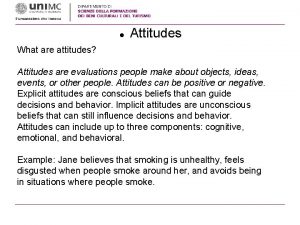The Aid Attitudes Tracker and changing attitudes in













- Slides: 13

The Aid Attitudes Tracker and changing attitudes in the UK Will Tucker, Director Will Tucker Consulting will@willtuckerconsulting. com

Public opinion matters “We have to improve our communication to the public and explain better what we do, why and what difference it makes; in more creative ways. It’s not legislation that protects the 0. 7%. It is the attitude and commitment of the British Public” Penny Mordaunt, UK Secretary of State for International Development, 26 February 2018

Key Attitudes Increase or decrease when given budget info’ • Almost half the population is fairly or very concerned about poverty in poor countries (47%) • Almost equal numbers want to cut aid as see it stay the same or increase (49% cut: 45% stay the same/ increase) • Over half the population think that overall aid is ineffective (47% score 0 -3 on effectiveness scale 010) 7% 4% 14% 25% 27% 24% Increase a great deal Increase somewhat Stay the same Decrease somewhat Decrease a great deal Don't know

Support for aid spending has been improving Of its total budget of nearly £ 732 billion, the UK Government currently allocates 1. 6 percent — £ 11. 8 billion to overseas aid to poor countries. Do you think that the Government should increase or decrease the amount of money that it spends on overseas 60% 50% 40% 30% 20% 17 v- 17 No 7 p. Se l-1 7 -1 ay Ju 7 -1 M ar 17 M n- 16 Ja v- 16 Stay the same/ increase No 6 p. Se l-1 6 -1 ay Ju 6 -1 M ar 16 M n- 15 Ja v- 15 No p- 5 Decrease Se l-1 5 -1 ay Ju 5 -1 M ar 15 M n- 14 Ja v- 14 No p- 4 Se l-1 4 -1 ay Ju 4 -1 M ar 14 M n- Ja No v- 13 0%

Engagement with global poverty is declining. 70% Which of the following have you done, if any, to become involved with international poverty and development as an issue? (Showing responses for ‘Have done in the last year’) 66% 61% 60% 59% 58% 57% 55% 54% 50% 36% 5% 4% 5% May-17 5% Mar-17 5% Jan-17 17% 14% Nov-16 17% Sep-16 17% Jul-16 18% 16% May-16 18% 17% Mar-16 22% Jan-16 23% Nov-15 22% Sep-15 23% Jul-15 5% 28% Mar-15 6% Jan-15 Mar-14 Jan-14 0% 8% Nov-13 10% 19% 18% Sep-14 20% 29% 20% 19% Jul-14 22% 21% May-14 30% May-15 30% Nov-14 40% Read, watched or listened to a news article about it, including offline and online Used your voice to impact the issue (e. g. via social media, signing a petition, etc. ) Donated money to an organization focused on the issue Fundraised by asking for donations from others for a cause I am involved in (such as a charity, or trip) Purchased products/services or boycotted products/services related to the issue In the last 3 years we have: • Lost ~1/3 rd of donors • Lost ~1/3 rd of fundraisers • Lost ~1/5 th of those writing to MPs • Lost ~1/5 th of those using their voice to impact on the issue People who are right wing are least likely to be engaging with global poverty issues.

How our insight helps: Increase Propensity Target Audiences Trigger Engagement

Behavioural segmentation 7% 4% 34% 17% 37% Totally Disengaged Marginally Engaged Behaviourally Engaged Fully Engaged Informationally Engaged

Drivers of engagement Engagement Perceptions Analysis which shows that on average a change in audiences’ underlying perceptions (identified through responses to a cluster of questions) creates a change in the level of engagement ‘up’ and ‘down’. By changing perceptions we can increase and decrease propensity.

Underlying perceptions which drive engagement Increase engagement Decrease engagement • Positive views of moral obligation to help poor • Positive economic outlook (both national economy and household) • Social norms of engagement and positive attitudes e. g. • Negative attitudes towards immigration • Political interest • Negative views on waste, corruption, inefficiencies

Pity, Empathy and Emotions…


Two emotions matter most when triggering donation • Hope triggers binary decision to donate • Hope also increases value of donation • Anger increases value of donation

How the UK sector is using this Individual Organisations, cross-sector campaign and DFID are: • Targeting disengaged audiences and those who want to cut aid to reverse decline and improve environment for policy • Increasing propensity to support by using drivers to inform communications • Using trigger insights to shape fundraising and marketing materials and to inform their own testing regimes
 Aid attitudes tracker
Aid attitudes tracker Laying the foundation for a quality culture
Laying the foundation for a quality culture Confederation changing british attitudes
Confederation changing british attitudes Antoine aime dorion
Antoine aime dorion First aid merit badge first aid kit
First aid merit badge first aid kit Neasden and greenhill medical centre
Neasden and greenhill medical centre Hình ảnh bộ gõ cơ thể búng tay
Hình ảnh bộ gõ cơ thể búng tay Slidetodoc
Slidetodoc Bổ thể
Bổ thể Tỉ lệ cơ thể trẻ em
Tỉ lệ cơ thể trẻ em Gấu đi như thế nào
Gấu đi như thế nào Glasgow thang điểm
Glasgow thang điểm Alleluia hat len nguoi oi
Alleluia hat len nguoi oi Môn thể thao bắt đầu bằng chữ f
Môn thể thao bắt đầu bằng chữ f

























